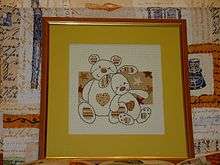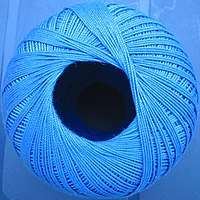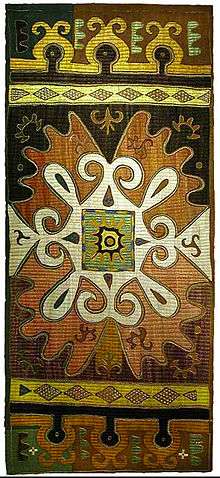Cross-stitch
Cross-stitch is a form of sewing and a popular form of counted-thread embroidery in which X-shaped stitches in a tiled, raster-like pattern are used to form a picture. The stitcher counts the threads on a piece of evenweave fabric (such as linen) in each direction so that the stitches are of uniform size and appearance. This form of cross-stitch is also called counted cross-stitch in order to distinguish it from other forms of cross-stitch.[1] Sometimes cross-stitch is done on designs printed on the fabric (stamped cross-stitch); the stitcher simply stitches over the printed pattern.[2] Cross-stitch is often executed on easily countable fabric called aida cloth[3] whose weave creates a plainly visible grid of squares with holes for the needle at each corner.

Fabrics used in cross-stitch include linen, aida, and mixed-content fabrics called 'evenweave' such as jobelan. All cross-stitch fabrics are technically "evenweave" as the term refers to the fact that the fabric is woven to make sure that there are the same number of threads per inch in both the warp and the weft (i.e. vertically and horizontally). Fabrics are categorized by threads per inch (referred to as 'count'), which can range from 11 to 40 count.
Counted cross-stitch projects are worked from a gridded pattern called a chart and can be used on any count fabric; the count of the fabric and the number of threads per stitch determine the size of the finished stitching. For example, if a given design is stitched on a 28 count cross-stitch fabric with each cross worked over two threads, the finished stitching size is the same as it would be on a 14 count aida fabric with each cross worked over one square. These methods are referred to as "2 over 2" (2 embroidery threads used to stitch over 2 fabric threads[4]) and "1 over 1" (1 embroidery thread used to stitch over 1 fabric thread or square), respectively. There are different methods of stitching a pattern, including the cross-country method where one colour is stitched at a time, or the parking method where one block of fabric is stitched at a time and the end of the thread is "parked" at the next point the same colour occurs in the pattern.
History

Cross-stitch is the oldest form of embroidery and can be found all over the world since the middle ages.[5] Many folk museums show examples of clothing decorated with cross-stitch, especially from continental Europe and Asia.[6]
The cross-stitch sampler is called that because it was generally stitched by a young girl to learn how to stitch and to record alphabet and other patterns to be used in her household sewing. These samples of her stitching could be referred back to over the years. Often, motifs and initials were stitched on household items to identify their owner, or simply to decorate the otherwise-plain cloth. The earliest known cross stitch sampler made in the United States is currently housed at Pilgrim Hall in Plymouth, Massachusetts.[7] The sampler was created by Loara Standish, daughter of Captain Myles Standish and pioneer of the Leviathan stitch, circa 1653.

Traditionally, cross-stitch was used to embellish items like household linens, tablecloths, dishcloths, and doilies (only a small portion of which would actually be embroidered, such as a border). Although there are many cross-stitchers who still employ it in this fashion, it is now increasingly popular to work the pattern on pieces of fabric and hang them on the wall for decoration. Cross-stitch is also often used to make greeting cards, pillowtops, or as inserts for box tops, coasters and trivets.
Multicoloured, shaded, painting-like patterns as we know them today are a fairly modern development, deriving from similar shaded patterns of Berlin wool work of the mid-nineteenth century. Besides designs created expressly for cross-stitch, there are software programs that convert a photograph or a fine art image into a chart suitable for stitching. One example of this is in the cross-stitched reproduction of the Sistine Chapel charted and stitched by Joanna Lopianowski-Roberts.[8][9]
There are many cross-stitching "guilds" and groups across the United States and Europe which offer classes, collaborate on large projects, stitch for charity, and provide other ways for local cross-stitchers to get to know one another. Individually owned local needlework shops (LNS) often have stitching nights at their shops, or host weekend stitching retreats.
Today, cotton floss is the most common embroidery thread. It is a thread made of mercerized cotton, composed of six strands that are only loosely twisted together and easily separable. While there are other manufacturers, the two most-commonly used (and oldest) brands are DMC and Anchor,[10] both of which have been manufacturing embroidery floss since the 1800s.[11][12]
Other materials used are pearl (or perle) cotton, Danish flower thread, silk and Rayon. Different wool threads, metallic threads or other novelty threads are also used, sometimes for the whole work, but often for accents and embellishments. Hand-dyed cross-stitch floss is created just as the name implies—it is dyed by hand. Because of this, there are variations in the amount of color throughout the thread. Some variations can be subtle, while some can be a huge contrast. Some also have more than one color per thread, which in the right project, creates amazing results.
Cross-stitch is widely used in traditional Palestinian dressmaking.
Related stitches and forms of embroidery


Other stitches are also often used in cross-stitch, among them quarter-, half-, and three-quarter-stitches and backstitches.
Cross-stitch is often used together with other stitches. A cross-stitch can come in a variety of prostational forms. It is sometimes used in crewel embroidery, especially in its more modern derivatives. It is also often used in needlepoint.
A specialized historical form of embroidery using cross-stitch is Assisi embroidery.
There are many stitches which are related to cross-stitch and were used in similar ways in earlier times. The best known are Italian cross-stitch, Celtic Cross Stitch, Irish Cross Stitch, long-armed cross-stitch, Ukrainian cross-stitch and Montenegrin stitch. Italian cross-stitch and Montenegrin stitch are reversible, meaning the work looks the same on both sides. These styles have a slightly different look than ordinary cross-stitch. These more difficult stitches are rarely used in mainstream embroidery, but they are still used to recreate historical pieces of embroidery or by the creative and adventurous stitcher.
The double cross-stitch, also known as a Leviathan stitch or Smyrna cross-stitch, combines a cross-stitch with an upright cross-stitch.
Berlin wool work and similar petit point stitchery resembles the heavily shaded, opulent styles of cross-stitch, and sometimes also used charted patterns on paper.
Cross-stitch is often combined with other popular forms of embroidery, such as Hardanger embroidery or blackwork embroidery. Cross-stitch may also be combined with other work, such as canvaswork or drawn thread work. Beadwork and other embellishments such as paillettes, charms, small buttons and specialty threads of various kinds may also be used.
Recent trends for cross stitch

Cross-stitch has become increasingly popular with the younger generation of Europe in recent years.[13] Retailers such as John Lewis experienced a 17% rise in sales of haberdashery products between 2009 and 2010.[14] Hobbycraft, a chain of stores selling craft supplies, also enjoyed an 11% increase in sales over the year to February 22, 2009.[15]
Knitting and cross-stitching have become more popular hobbies for a younger market, in contrast to its traditional reputation as a hobby for retirees.[16] Sewing and craft groups such as Stitch and Bitch London have resurrected the idea of the traditional craft club.[17] At Clothes Show Live 2010 there was a new area called "Sknitch" promoting modern sewing, knitting and embroidery.[18]
In a departure from the traditional designs associated with cross-stitch, there is a current trend for more postmodern or tongue-in-cheek designs featuring retro images or contemporary sayings. It is linked to a concept known as 'subversive cross-stitch', which involves more risque designs, often fusing the traditional sampler style with sayings designed to shock or be incongruous with the old-fashioned image of cross-stitch.
Stitching designs on other materials can be accomplished by using waste canvas. This is a temporary gridded canvas similar to regular canvas used for embroidery that is held together by a water-soluble glue, which is removed after completion of stitch design. Other crafters have taken to cross-stitching on all manner of gridded objects as well including old kitchen strainers or chain-link fences.
Cross-Stitch and Feminism
In the 21st Century, an emphasis on feminist design has emerged within cross-stitch communities.[19] There are collections of patterns available with feminist themes,[20] and many more feminist patterns online. Some cross-stitchers have commented on the way that the practice of embroidery makes them feel connected to the women who practised it before them.[21] There is a push for all embroidery, including cross-stitch, to be respected as a significant art form.[22]
Flosstube
An increasingly popular activity for cross-stitchers is to watch and make YouTube videos detailing their hobby. Flosstubers, as they are known, typically cover WIPs (Works in Progress), FOs (Finished Objects), and Haul (new patterns, thread, and fabric, as well as cross-stitching accessories, such as needleminders).
See also

- Mosaic
- Pixel art
- Embroidery
Notes
- Nicholas, Kristin (2015). The Amazing Stitching Handbook for Kids. Concord, CA: C&T Publishing. pp. 33. ISBN 978-1-60705-973-8.
- Sutcliffe, Kristen (2013). Fabric Paper Thread. Concord, CA: C&T Publishing. p. 138. ISBN 978-1-60705-715-4.
- Baker Montano, Judith (2016). Judith Baker Montano's Essential Stitch Guide. Concord, CA: C&T Publishing. p. 9. ISBN 978-1-61745-077-8.
- Studio Koekoek cross stitch blog (2018). "How to Cross Stitch over 2 threads or more". www.studio-koekoek.com.
- Gillow, John, and Bryan Sentance: World Textiles, Bulfinch Press/Little, Brown, 1999, ISBN 0-8212-2621-5, p. 181
- Threads (magazine), Issue 11, June/July 1987
- "Loara Standish Sampler". pilgrimhall.org. Archived from the original on 2007-12-18. Retrieved 2017-04-30.
- Gwen Magee (Gwendolyn) (2010-08-27). "Textile Arts Resource Guide: The Sistine Chapel in Cross-Stitch". Creativityjourney.blogspot.com. Retrieved 2013-12-29.
- "Cross-stitch recreation of Sistine Chapel ceiling". Telegraph. London. 2009-06-25. Retrieved 2013-12-29.
- "Archived copy". Archived from the original on 2012-07-28. Retrieved 2012-08-09.CS1 maint: archived copy as title (link)
- "DMC History". Dmc-usa.com. Archived from the original on 9 February 2017.
- "Coats History". Coatsandclark.com. Archived from the original on 2013-11-05. Retrieved 2013-12-29.
- "Welcome to CrossStitcher | Subscription Website". crossstitchermagazine.co.uk. Retrieved 2017-04-30.
- Wilson, Bill (2009-08-28). "The modern 'make do and mend'". BBC News.
- Hall, James (2010-01-18). "Hobbycraft sews up strong sales". The Daily Telegraph. London.
- Farry, Eithne (2006-05-29). "¡Viva las craftivistas!". The Guardian. London.
- "I Knit London, the UK's First Official Stitch 'n Bitch Day". iknit.org.uk. Archived from the original on 2008-04-07. Retrieved 2017-04-30.
- "Sknitch — what's it all about?". ClothesShowLive.com. Archived from the original on 2011-02-28. Retrieved 2011-03-29.
- Wickman, Kase (September 26, 2017). "How Feminist Cross Stitching Became A Tool Of The Resistance". Bustle.
- "Feminist Cross-Stitch: 40 Bold and Fierce Patterns". Publishers Weekly (book review). February 1, 2019.
- Kim, E. Tammy (December 29, 2018). "The Feminist Power of Embroidery". The New York Times.
- Giliforte, Brittany; Goulem, Brigid (September 18, 2018). "Stitching into Feminism". The Queen's Journal.
References
- Caulfield, S. F. A., and B. C. Saward, The Dictionary of Needlework, 1885.
- Enthoven, Jacqueline: The Creative Stitches of Embroidery, Van Norstrand Rheinhold, 1964, ISBN 0-442-22318-8.
- Gillow, John, and Bryan Sentance: World Textiles, Bulfinch Press/Little, Brown, 1999, ISBN 0-8212-2621-5.
- Reader's Digest, Complete Guide to Needlework. The Reader's Digest Association, Inc. (March 1992) ISBN 0-89577-059-8.
External links
| Wikimedia Commons has media related to Cross-stitching. |
- Articles related to the recent comeback in popularity of cross stitch. "Is Cross Stitch Dead?"



